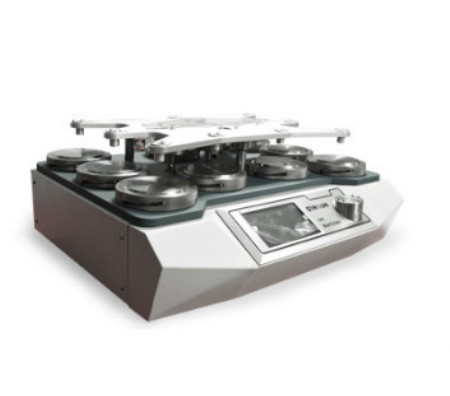-
What is the best way to test leather for automotive interior textiles?
Edited by:Read:One very important application of leather textiles is used in the field of automotive interiors. With the rapid development of the automotive industry, the industry has become increasingly stringent in testing the wear resistance of automotive leather textiles. This article is about information related to wear resistance testing of automotive leather.
We interviewed the technical consultant of QINSUN textile testing instrument manufacturer, he said that there are very many methods for testing the abrasion resistance of automotive leather, and the main testing methods on the market at present are Taber abrasion method, Martindale abrasion method and STROLL abrasion method.
Taber wear method: American standard ASTM D 3884-2009 on the TABER wear method, the test instrument is Taber Abrasion Resistance Tester.
Test principle:
The specimen being tested is placed on a rotating platform, and the specimen is worn by the rotating friction motion of the two rolling friction wheels above it under a certain load against the specimen. One friction wheel faces outward and the other friction wheel faces inward, forming a circular wear mark. After a specified number of rubbing cycles, the degree of wear of the specimen is evaluated visually.

Operation procedure:
The specimen is fixed face up on the rotating platform and the selected grinding wheel is mounted on the support lever. After selecting the appropriate load, lower the support lever so that the grinding wheel is in contact with the specimen surface, connect and turn on the dust extraction device. Start the instrument and perform the test according to the number of rotations set by the counter. After the test, remove the specimen, check and record the wear of the specimen, and use the gray sample card according to GB/T 250-2008 "Textile color fastness test Gray sample card for evaluating color change".
Martindale abrasion method:
Martindale abrasion resistance method is often used for textile abrasion resistance test and pilling evaluation, Martindale Abrasion Tester is the test instrument, GB/T3903.16-2008 "Footwear Uppers, Lining and Insole Test Methods Abrasion Resistance" stipulates the test method for testing shoe uppers by Martindale method, and it is also applicable to the test of abrasion resistance of automotive leather.
Using the Martindale abrasion method, the specimen is rubbed with standard friction fabric under constant pressure. The relative motion between the rubbing fabric and the specimen is carried out by the Lissajous pattern, generating friction in all directions. The degree of damage to the specimen is evaluated after completing the required number of rubs.
When operating, a piece of polyurethane foam with a thickness of (3±1) mm and a density of (30±3) kg/m3 is padded flat on the back of the specimen, and the specimen is fixed to the grinding head with a clamp ring, then the table felt is placed on the grinding table, then the friction fabric is placed on the table felt, and a weight generating (2±0.2) kPa pressure is placed on the friction fabric, and then the friction fabric is fixed. After that, the abrasive head is mounted on the abrasion testing machine and a pressure of (12±0.2)kPa is applied to the abrasive head, and the instrument is started and tested according to the number of rotations set by the counter. After the test, remove the specimen, check and record the abrasion of the specimen, and use the gray sample card to evaluate the color change in the test area according to GB/T 250-2008 "Textile color fastness test Gray sample card for evaluating color change".

STROLL abrasion method:
The STROLL abrasion resistance method test principle is that the tested sample is placed on an inflatable rubber diaphragm with constant air pressure, and the sample is rubbed using sandpaper with surface characteristics. After a specified number of rubs, the degree of wear of the specimen is evaluated by appearance.
Standard: ASTM D3886-1999
Operation procedure:
The specimen is placed on the rubber membrane in a flat state, and the sandpaper is placed on the abrasive plate with the contact head attached to the sandpaper flush with the surface of the sandpaper. Then apply an air pressure of 28kPa below the diaphragm and 454g above the abrasive plate, and make sure that the control of air pressure and the contact between the inflated sample and the loaded sandpaper are in a stable and balanced state. Start the instrument and perform the test according to the number of rotations set by the counter. After the test, remove the specimen, check and record the wear of the specimen, and use the gray sample card to evaluate the color change in the test area according to GB/T250-2008 "Textile Color Fastness Test: Gray Sample Card for Evaluating Color Change".
- 2024-04-19Paper ring compression strength tester standards
- 2024-04-19Cupping tester standards
- 2024-04-19Rubber and plastic tensile tester standards
- 2024-04-19Taber 1750 wear-resistant tester standards
- 2024-04-19Stone Chip Resistance Gravelometer standards
- 2024-04-18Diaper absorption speed tester standards
- 2024-04-18Diaper leakage tester technical indicators
- 2024-04-18Paint film impact resistance tester standards
- 2024-04-18Low temperature brittleness tester principle
- 2024-04-18Battery separator permeability tester technical indicators



